|
Amiga Forever
by
Michael C. Battilana
Ed. Fleecy Moss, CTO of Amiga Inc. asked Michael
C. Battilana to give us a bit of history of Amiga Forever [http://www.amigaforever.com/] and what they
are trying to do with it.
Dear Fleecy, this is a difficult question. it
feels like "what did you do and what are you trying to do with
your life?" :-)
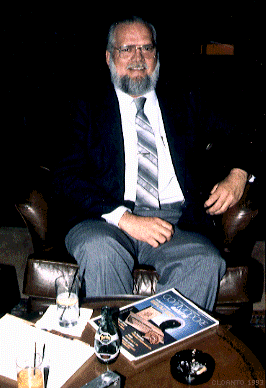 The fact is, the Amiga's
history, for many of us who are Amigans since the mid-80s,
walks hand in hand with the history of ourselves when we had
not just a lot more hair, but also some very special dreams
and hopes, which nobody would ever want to give up. The Amiga
offered to us, young people full of ideals, and dreams, and
passion, not only the illusion of uncompromising excellence,
but also the tangible and somewhat subversive proof that life
under these conditions is possible. The unique synergy of
gifted people and technological events which led to a system
that clearly stood out as the best hardware and the best
operating system around also attracted a special community and
ignited a chain reaction of collective dreams. When we were
working with our Amiga 1000s, 2000s and 3000s, we not only
were extremely productive with a system of which we knew every
operating system file and function, but we enjoyed it too.
Now, you gave us an addictive drug, we want more of it, and
you ask why? :-) The fact is, the Amiga's
history, for many of us who are Amigans since the mid-80s,
walks hand in hand with the history of ourselves when we had
not just a lot more hair, but also some very special dreams
and hopes, which nobody would ever want to give up. The Amiga
offered to us, young people full of ideals, and dreams, and
passion, not only the illusion of uncompromising excellence,
but also the tangible and somewhat subversive proof that life
under these conditions is possible. The unique synergy of
gifted people and technological events which led to a system
that clearly stood out as the best hardware and the best
operating system around also attracted a special community and
ignited a chain reaction of collective dreams. When we were
working with our Amiga 1000s, 2000s and 3000s, we not only
were extremely productive with a system of which we knew every
operating system file and function, but we enjoyed it too.
Now, you gave us an addictive drug, we want more of it, and
you ask why? :-)
Intimately, beyond the obvious, I don't know why!
Is it because we miss those pre-New Economy years, when
technology was less about noise and marketing and more about
crafting fine things? Is it because, very simply, we were 10
or 20 years younger? It's a bit of all of this, I guess. Amiga
Forever attract users who always wished an Amiga, but could
never afford one, but also people who are always trying to
learn something new, and people who are too old to keep
learning something new, for which the current pace of
technological change is a small handicap. To us Amiga users
who felt the magic of those years, and suddenly learned to
know the fear of failing custom chips with no spare parts,
emulation felt like a new lease of life. Each time I use the
Amiga emulation on my notebook, it feels like magic. And this
occurs every day. Thanks to Amiga Forever, when we had to
start working in offices full of PCs we could bring our Amiga
projects with us, and impress our co-workers with Amiga. And
when we had to work with an Amiga and a PC side by side, all
the connectivity software on Amiga Forever felt very useful
too.
But, like for the original Amiga, it takes people
to make dreams come alive. About 10 years ago, a few of us
Amiga users who had experienced excellent Atari and Mac
"emulation" (there wasn't really much to emulate) on the
Amiga, were beginning to wonder about the possibility of
emulating the Amiga hardware and its custom chips on
increasingly powerful PCs. I remember, back in April 1994, the
same month in which Dave Haynie shot his famous Deathbed Vigil
video (now also included on Amiga Forever, courtesy of Dave)
right before Commodore in West Chester closed, I was
exchanging sad emails with Carolyn and others there, also
discussing the possibility of using new CPUs (I, like many
Amiga users, was a big PowerPC fan back then) and multitasking
operating systems (like OS/2) to build an Amiga emulation.
After all, even Apple had already started its successful 68K
to PowerPC migration strategy with its Macintosh Application
Environment (MAE) emulation software.
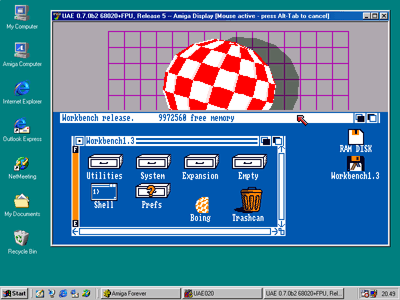 So,
once again, there was a flow of ideas in the air, and CPUs
(which then like now were doubling in power every 18 months)
were beginning to approach a realm where even an emulation of
the complex Amiga hardware could be within reach. But it took
one person, Bernd Schmidt, in Germany, to prove even those who
would never have thought an Amiga notebook to be possible,
that they were wrong. In March 1995, a black-and-white picture
of the Kickstart 1.3 boot screen appeared for the first time
on his 90 MHz Pentium system running Linux. The U in UAE did
not stand for Unusable any more! While Apple was busy adding
dynamic recompilation (similar to today's just-in-time
technology) to its MAE system, Bernd was hard at work on the
emulation of the Amiga custom chips. In late 1995, UAE 0.2 was
finally released to an anxious public of high end PC
users. So,
once again, there was a flow of ideas in the air, and CPUs
(which then like now were doubling in power every 18 months)
were beginning to approach a realm where even an emulation of
the complex Amiga hardware could be within reach. But it took
one person, Bernd Schmidt, in Germany, to prove even those who
would never have thought an Amiga notebook to be possible,
that they were wrong. In March 1995, a black-and-white picture
of the Kickstart 1.3 boot screen appeared for the first time
on his 90 MHz Pentium system running Linux. The U in UAE did
not stand for Unusable any more! While Apple was busy adding
dynamic recompilation (similar to today's just-in-time
technology) to its MAE system, Bernd was hard at work on the
emulation of the Amiga custom chips. In late 1995, UAE 0.2 was
finally released to an anxious public of high end PC
users.
It didn't take long for smart people to notice the
potential of the new Amiga emulation technology. Some former
Commodore-Amiga engineers publicly stated that "UAE certainly
does violate the Amiga patents". Remember, these were the days
where the first emulators for game consoles were appearing and
quickly disappearing in the courts. Companies like Apple were
fighting unauthorized Mac emulators. The internet was
beginning to become a popular medium for Amiga ROM and
operating system files to be "exchanged". At some point,
Gateway officials said that "something had to be done".
Probably, and understandably, they felt that they had to
defend their multimillion dollar investment in Amiga
intellectual property assets.
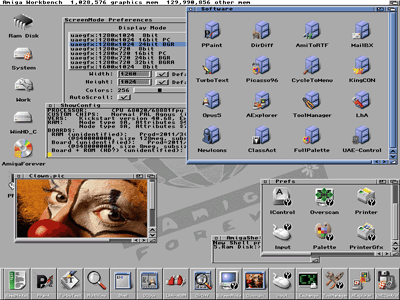 During
the spring of 1997, when Brian King, who took over from
Mathias Ormann the Windows port of UAE, was working at Cloanto
in Italy, and while our Amiga sales were forcing us to look
for new horizons on the PC, we all got more involved in
Amiga-PC coexistence and data sharing needs. For example, my
own Amiga 3000, which had been running day and night for seven
years, had a broken SCSI chip which I "replaced" with an
Oktagon card, and a custom chip was beginning to fail as well.
Within the context of a total lack of Amiga-related news and
developments, all of this felt very sad. Personal Paint 8 was
put on hold, waiting for a new Amiga operating system and
hardware architecture. We were beginning to work on boring PC
software. :-( During
the spring of 1997, when Brian King, who took over from
Mathias Ormann the Windows port of UAE, was working at Cloanto
in Italy, and while our Amiga sales were forcing us to look
for new horizons on the PC, we all got more involved in
Amiga-PC coexistence and data sharing needs. For example, my
own Amiga 3000, which had been running day and night for seven
years, had a broken SCSI chip which I "replaced" with an
Oktagon card, and a custom chip was beginning to fail as well.
Within the context of a total lack of Amiga-related news and
developments, all of this felt very sad. Personal Paint 8 was
put on hold, waiting for a new Amiga operating system and
hardware architecture. We were beginning to work on boring PC
software. :-(
But that Amiga emulation effort, with its mix of
challenging legal issues and possible futures, still sounded
like an intriguing idea. It was something which we felt
strongly about, because it reflected our own passions and
needs, as long time Amiga users. Reality demanded that we have
Amiga and PC hardware, software and data side by side, and we
knew that our Amiga friends and customers also increasingly
had this need. I loved UAE, and I had been in touch with Bernd
for some time. Also, there were a lot of other contributors
involved (the UAE software was not yet GPL), so an agreement
was not easy: we would have had to contact every single author
of every single line of code. At the same time, a certain
pressure from Gateway/Amiga staff and in Usenet groups
appeared to be rising. Towards the end of the summer, at the
end of an exchange of emails and phone calls with
Gateway/Amiga, we decided to meet, to discuss both Personal
Paint matters and to explore the possibility of giving Amiga
emulation an official blessing. We met in Frankfurt in early
September. Petro had never seen a notebook booting an Amiga or
playing the bouncing ball demo. But this was not what
convinced him. You know, I never told this to anybody, but.
Petro's Windows 95 PC (in his office) was not working
properly, and he had been waiting all day for a technician.
So, after we talked, I offered to have a look at it. I
reinstalled Windows, and fixed everything without disrupting
his software configuration. I think, on a personal basis, that
helped. Amiga Forever, and with it legal Amiga emulation, may
perhaps not have been possible if it hadn't been for a Windows
malfunction. :-) After that, I believe that he began to trust
us more. But still, it was not enough to convince Gateway.
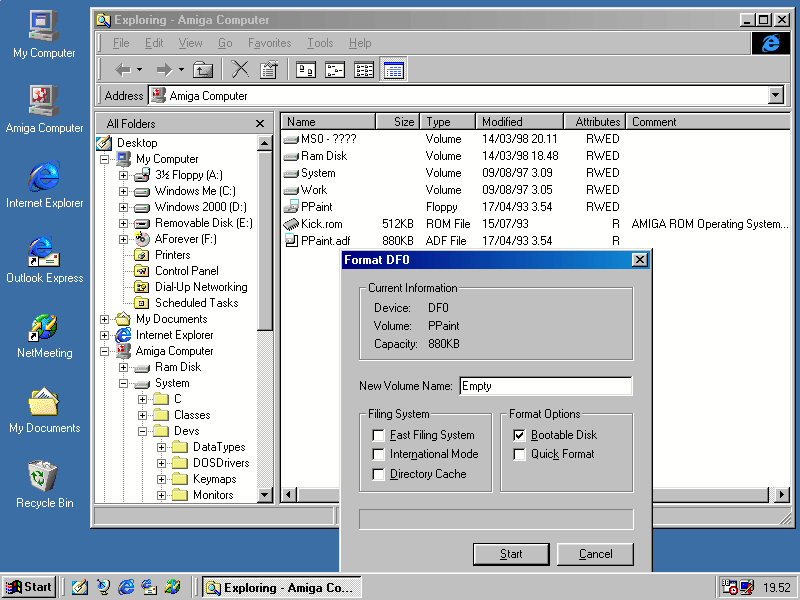
[Pictured: Amiga Explorer in use; included in
Amiga Forever]
While we had already been busy for months working
on Amiga Explorer (the easy to set up Amiga-PC networking
software included in Amiga Forever), and we were contacting
all emulation developers to obtain their permission and help
(with the approval of Bernd, Mathias and other UAE "spiritual
leaders"), we still did not have the final OK from Gateway for
the Amiga Forever project. That came only after the meeting of UAE developers in Freiburg. At
last, at the end of September 1997, we obtained the license to
all Amiga patents, trademarks, and copyrights required for the
Amiga hardware emulation and ROM and OS files, inclusive of
the official "Powered by Amiga" logo. This gave us little more
than a month to prepare a version 1.0 product for the Computer
'97 show in Cologne.
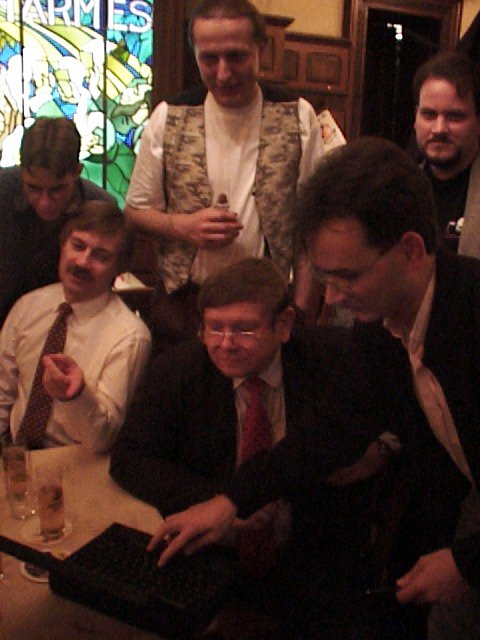
[Pictured: Amiga Forever 1.0 demonstration at
Amiga dinner on November 15, 1997. Some people who later in
2001 claimed that their product was "the first Amiga notebook"
were also in the room, which led to exchanges of opinions such
as the one here :-)]
 Amiga
Forever 1.0 already embodied the initial concept that we are
still working on: easy to access Amiga emulation, data
sharing, and culture. The first version contained an interview
I did with Jay Miner in 1990, and which was the first step of
a digital archive which currently amounts to over one terabyte
of digitized video data (if any of your readers has some
interesting videos, I would like to encourage them to contact
me, we will do professional conversions to digital at no
cost). Among other things, we felt that it was important for
the emulation to run straight from CD, if so desired, so
people could use it and show it at school, university, and
work, without having to install it. And we wanted to offer
some easy to use Amiga-to-PC data sharing software. Just as
people said that Amiga emulation was impossible, there were
engineers who said that it would be impossible for some
software to self-transfer over a serial cable (with no
software on the Amiga side other than a boot disk), but we did
just that. I like to believe that with Amiga Forever we
contributed a little bit to keep the magic of Amiga alive,
supporting a community of faithful Amiga users with aging
hardware, and sharing it with new Amiga friends. This also
allowed Amiga emulation to prosper and evolve under a legal
umbrella, to the point where it might now help, for example,
to support legacy Amiga software that needs to run on Amiga OS
4.0. Amiga Forever 5.0 includes more than 100 individually
licensed components, ranging from GIF/LZW technology patented
by Unisys, to Picasso96 drivers, to applications, to icons, to
palettes, to videos. We even managed to re-license old gems
such as the Amiga speech synthesis (Commodore-Amiga had not
renewed this license). Sadly, Amiga interest appeared to slow
down a bit over the past few years, so that we did not keep up
with the yearly pace of previous Amiga Forever updates from
version 1.0 to 5.0. The last version of Amiga Forever dates
back to 2001, however we kept providing free online updates.
We appreciate the trust that people put in us, making this
experience of a lifetime possible, and one way or another we
will keep working to improve this package and add new and
exciting content. Amiga
Forever 1.0 already embodied the initial concept that we are
still working on: easy to access Amiga emulation, data
sharing, and culture. The first version contained an interview
I did with Jay Miner in 1990, and which was the first step of
a digital archive which currently amounts to over one terabyte
of digitized video data (if any of your readers has some
interesting videos, I would like to encourage them to contact
me, we will do professional conversions to digital at no
cost). Among other things, we felt that it was important for
the emulation to run straight from CD, if so desired, so
people could use it and show it at school, university, and
work, without having to install it. And we wanted to offer
some easy to use Amiga-to-PC data sharing software. Just as
people said that Amiga emulation was impossible, there were
engineers who said that it would be impossible for some
software to self-transfer over a serial cable (with no
software on the Amiga side other than a boot disk), but we did
just that. I like to believe that with Amiga Forever we
contributed a little bit to keep the magic of Amiga alive,
supporting a community of faithful Amiga users with aging
hardware, and sharing it with new Amiga friends. This also
allowed Amiga emulation to prosper and evolve under a legal
umbrella, to the point where it might now help, for example,
to support legacy Amiga software that needs to run on Amiga OS
4.0. Amiga Forever 5.0 includes more than 100 individually
licensed components, ranging from GIF/LZW technology patented
by Unisys, to Picasso96 drivers, to applications, to icons, to
palettes, to videos. We even managed to re-license old gems
such as the Amiga speech synthesis (Commodore-Amiga had not
renewed this license). Sadly, Amiga interest appeared to slow
down a bit over the past few years, so that we did not keep up
with the yearly pace of previous Amiga Forever updates from
version 1.0 to 5.0. The last version of Amiga Forever dates
back to 2001, however we kept providing free online updates.
We appreciate the trust that people put in us, making this
experience of a lifetime possible, and one way or another we
will keep working to improve this package and add new and
exciting content.
It has to be mentioned that we did not make
everybody happy with this project. During the fall of 1997
some people even wrote that they would place a bomb in our
building for what we were doing, i.e. "killing the Amiga"
[which led to this]. On the opposite end, some emulation
supporters who did not seem to care much about intellectual
property rights were heard saying similar things. :-) I think,
only time can tell whether these were good choices or not. We
certainly embraced it with enthusiasm, with the perspective of
users who needed this very badly ourselves, and with deep
respect and daily gratitude towards Bernd and all other
contributors (the Credits section in Amiga Forever lists the
names of several hundred people). Commercially, I don't know
whether it has been time well-spent. But for sure, it felt
better than full time on high end but somewhat boring
accounting software. :-) This has been a lot of fun, and it
allowed us to stay in touch with this wonderful community in
spite of very difficult times.
Thank you everybody, for making all of this
possible, yesterday, today, and tomorrow.
Michael C. Battilana and your Cloanto
Team |






